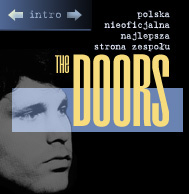|
Article
by Bruce Harris 1991
Film Sensibility Set The Doors Apart
As a joke I once asked Jim Morrison to name the group he most
liked to listen to besides the Doors. He pondered this question
thoughtfully for a few moments, as though it were the toughest
question in the world, and then replied, "You know the sound-
track from Fellini's '8 1/2'? I really like that."
Morrison's world was the world of film. In sharp contrast to the
rest of the Doors, Jim had no pick-hit top 10 favorites. He was
certainly not a "music fan" in the common manner of the 60': each
new Beatles album was not a revelation for him; the Jefferson
Airplane did not carry the message of his day; the stylistic ex-
periments of the Byrds did not move him. He listened a bit to
Dylan (but only "John Wesley Harding"), and he occasionally
mentioned Elvis. But he much preferred watching Alfred Hitch-
cock's "The 39 Steps" to hearing anything.
Appropriately enough, one of the Doors only "cover" songs was
"Alabama Song (Whiskey Bar)," a Kurt Weill-Bertolt Brecht mu-
sical theater piece. Originally performed by Lotte Lenya and later
recorded by David Bowie in the 80's, "Alabama Song" was recently
sung by Sting in the Broadway production of "The Threepenny Opera."
The influence of theater and film on the Doors set them apart from
their contemporaries. While the Beatles drew upon Carl Perkins
and Buddy Holly, and the Rolling Stones drew upon Chuck Berry and
the R & B music of the 50's, the Doors forged a completely different
lyrical and musical path. And their apartness is reflected in their lack
of descendants. Countless groups have tried to imitate the Beatles,
but there is no Bee Gees or Badfinger or Jellyfish to compare with
the Doors. this is because, for all their tremendous impact and
success, the Doors have always been more of a monument than
an influence.
Morrison's image was a cinematic mystique made up of the masc-
uline/feminine mystery of Marlene Dietrich, the tragic (vaguely
psychotic) fragility of Greta Garbo, and the tough yet sensitive
soul of James Dean. Jim was rock's first true actor. He made re-
citative a major part of every Doors recording and performance.
He spoke lines and created theater, but the true drama of the
Doors lay in the suspense created by his self-destructive ten-
dencies, evolving at last into a sort of living theater for the
dying. There was a sense at a lot of Doors concerts that maybe
tonight no one would get out of here alive.
It is of note that all this visual communication took place in an era
before the explosion of music video, before MTV, and before the
broad media coverage of rock artists. In their heyday, more people
heard the Doors via their albums and hit records on the radio than
ever got to see them past an LP cover.
Hence it is fascinating to consider what might have happened if
the Doors, instead of being a 60's group, had been a new act
contending in today's marketplace. Would they be the masters of
the video vehicle of exposure or victims of it? "The End" would
seem like quite a different entity in heavy rotation on MTV.
Every skin pore, every drop of sweat, every hemidemisemiquaver
of a gesture would be under the video microscope. And repitition
in the TV eye can breed, if not contempt, then certainly boredom.
Nevertheless, there is no question that, had the Doors come
along later, they would have been master manipulators of the
video image. Like David Bowie, Michael Jackson, and Madonna,
who are among today's leading video performers, Morrison was
a pioneer. Everything from his film-school background to his
outrageous stage antics suggests that, were he breaking on
through in the 90's, he would be a leader in the video field.
Even back in the 60's, Morrison's film for the Doors' single
"The Unknown Soldier" was utterly revolutionary. It told a
story with Jim starring as a Christ-like figure executed by the
other Doors members, no less. And it intercut surreal blood-
and-roses religious imagery with harsh TV news realities,
creating a visual Greek chorus to the action.
Oliver Stone's bio-pic "The Doors", really a two-hour long rock
video, shows what the Doors might be doing visually if they were
still intact: Their videos might well look like Stone's movie.
Largely due to their intrinsic cinematic qualities, the Doors' image
and music are still as vital now as they were the day "Light My
Fire" went to No. 1.
"My eyes have seen you," Jim sang, "Free from disguise, gazing
on a city under television skies." He subtitles his first published
book of poetry, "Notes On Vision." He had the vision to become
the vision. Unfortunately, Jim Morrison's life was his first and
only video. It is of little consolation that the flame that burns
twice as bright burns half as long.
Billboard Magazine
April 21, 1991
|
